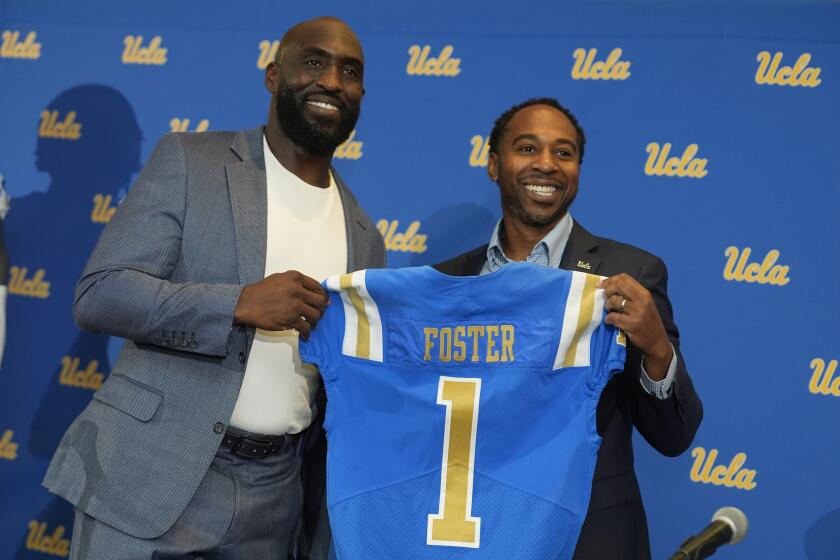Over a century of black history in the making : The Afro-American, a newspaper founded by an emancipated slave, looks to new challenges.
BALTIMORE — He remembers clearly all those times he wasn’t allowed to sit in the press box. One time, at the old Pelican Stadium in New Orleans, he was actually forced to sit on the roof. Grabbing a chair from somewhere, he trudged up what seemed like a mountain of steps and watched the game from an especially precarious point-of-view.
It wasn’t easy being a black sportswriter in the segregated South, but Sam Lacy managed to endure. In 1948, he became the first black member of the United States Baseball Writers Assn. Now he’s 88 years old, probably the oldest active sportswriter in the country. But his longevity is topped by the paper he works for--the Baltimore Afro-American, which recently celebrated its 100th anniversary. It is the oldest continuously published, family-owned black newspaper in America.
“Years ago, the only thing you read in the newspapers about African-Americans was all crime,” says Lacy. “There was never anything positive. The role of the African-American press is to report the positive things, and police the major papers.”
That, and much more. The African-American press was a training ground for black journalists like syndicated columnist Carl Rowan and Oakland Tribune Publisher Robert C. Maynard, who both worked here at one time. It was an outlet for black advertisers, an easier and cheaper way for them to reach their target audience. And it was a community bulletin board, social calendar, advocate for causes.
“Society has changed and demands different things now,” says Ernie Boston, editor of the paper. “Years ago, people were interested in the segregation issue, and the black press was one of the few places you could read about it. But that issue has basically been overcome, so now there’s more of an interest in things like AIDS, the homeless and hunger.”
The Afro-American was founded in 1892 by John H. Murphy Sr., an emancipated slave. When he died 30 years later, the paper was a 12-page weekly with a circulation of 14,000.
Ownership of the paper then passed to his son, Carl, who built it into a small chain that, during its peak in the 1950s and ‘60s, published twice-weekly editions for 13 cities, with a total circulation of 300,000. The weekly currently publishes in Baltimore, Washington and Richmond, Va., with an estimated circulation of 25,000 to 50,000.
The paper, which is now run by the fourth generation of the Murphy family, still operates out of the building it has occupied since 1911. It is a cluttered, somewhat crumbling office space, located about a mile due north of the brand new ballpark at Camden Yards. The building is filled with old metal desks and chairs and has the look of a newsroom caught in a time warp. But there is a significant concession to the modern era--computerization.
Last month, the Afro-American issued a centennial edition that ran to 96 pages. It is a fascinating historical document, containing reproductions of full pages from the paper dating back as far as 1912. The issue from Dec. 21 of that year, for example, includes stories about racial discrimination in the Navy, infighting among black Democrats and a recent visit by Booker T. Washington to the nation’s capital.
Other pages feature a treasure-house of historical information, running from the trivial to the world-shattering: numerous ads for skin lightener; coverage of Joe Louis’ boxing career; a “Junior Afro” page from 1933; full reporting of the 1968 Washington, D.C., riots; a 1932 headline--”Hotcha Comes and Goes but Harmony Holds Its Own”--which tops a story comparing the music of frenetic Cab Calloway with the mellower Southernaires.
It’s fascinating stuff, but there’s also a whiff of the anachronism about it. Now that there are more blacks in the nation’s newsrooms, and the black community is being covered more thoroughly (although still not enough to satisfy most black readers), the question of whether the black press is actually necessary comes up.
In nearby Philadelphia, a new black-oriented Sunday tabloid made its debut Sunday. “We’ll focus on the positive aspects and go more in-depth into the negatives like drugs, crime, family disintegration, Africa and other parts of the Third World,” said Publisher J. Whyatt Mondesire. It will be Philadelphia’s third black-run paper.
“The mainstream press has hired black reporters to cover black stories,” says Afro-American editor Boston, “but the white press still only looks at us on certain occasions. I think our role here is to lead black society into the future, to show the community what the issues are.”
Sam Lacy sees both sides of the coin. He thinks papers like the Afro-American still have a role, a mission to “report positive things and do in-depth, analytical stories.” But he also feels that where once the black press was an institution, it is now “considered secondary; a lot of people say we’re rehashing what’s in the white papers.”
Has time passed the Afro-American by? Lacy doesn’t skip a beat when answering. “I don’t worry about it,” he says, “but I’m afraid it has.”
More to Read
Go beyond the scoreboard
Get the latest on L.A.'s teams in the daily Sports Report newsletter.
You may occasionally receive promotional content from the Los Angeles Times.










